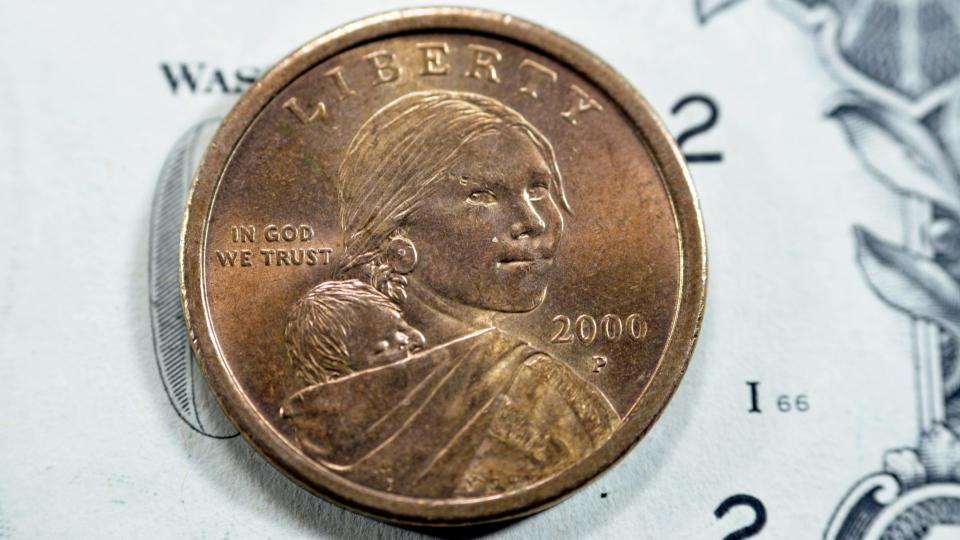$15,000 Sacagawea Dollar? Check Your Coins for Mint Mistakes Worth a Pretty Penny

If you are a rare coin collector, you know it’s not always the perfect coins that are the most valuable. There are many criteria that make a coin worth lots of money in today’s currency, as well as several do’s and don’ts to take into account if you happen to find a rare specimen of coin out in the world.
Read Next: 8 Rare Coins Worth Millions That Are Highly Coveted by Coin Collectors
Try This: How To Get $340 Per Year in Cash Back on Gas and Other Things You Already Buy
Most of the time, a past mistake in the printing and minting of the coin only raises the price when it is appraised in the present day. That includes the 2000-P Sacagawea transitional error dollar coin.
“I was the person who discovered the 2000-P Pattern reverse, or transitional error if you prefer. It was quite by accident,” says Tom DeLorey, a coin enthusiast who is credited in many collector circles with originally finding the flaw. “After the Mint PR man demonstrated the coins being used in a variety of vending machines while the cameras rolled, I got to hold and examine one and I made some mental notes as to the design.”
The types of mint flaws DeLorey was searching for included planchet errors (mishandled preparation of “blank” coins), die errors (where lettering, numbers and images are misprinted on either side of the coin) and strike errors (uneven printing or wrong sized planchet pressing, to name a few commonplace ones).
“The very first issue of the Sacagawea coins came in Cheerios boxes starting Jan. 1, 2000, but those coins were packaged in such a way that you could not see their reverse,” DeLorey continues. “Then, when the dollars received their first general release through Walmart in late January of 2000, I went and got some and noticed that the tail feather design had been changed.”
DeLorey recounts that the U.S. Mint denied any variance or mistake, but the coin’s designer informed DeLorey that he had “changed the tail feathers at the last minute to better represent the white tail feathers of an American bald eagle.”
This misprinted 2000-P Sacagawea coin is commonly referred to as a “mule” because of the mismatching of an obverse die and reverse die combined together. Only 19 examples are known to be out there, all in mint condition, with an average sale price between $15,000 and $50,000.
There are a few other rare coins that are worth big bucks today due to a variety of minting errors. Here are some of the top coins to be on the lookout for.
2004-D Extra Leaf Wisconsin State Quarters
Estimated value: $50-$100
These quarters are actually the result of a die flaw that produced two different variations, creating what’s referred to now as “Extra High Leaf and Extra Low Leaf errors.” Once the public caught wind, the coins went for $500 apiece, but have since dropped in price.
Check Out: 9 Most Valuable American Quarters in Circulation
1955 DDO Lincoln Cent
Estimated value: Starting at $1,000
The doubled die obverse Lincoln cent ranks among the most iconic error-associated coins in American history. The twice-printed “1955” stands out due to dies that were improperly prepared before minting.
1937-D 3-Legged Buffalo Nickel
Estimated value: $500-$2,500
A misprinting of a buffalo — giving it only three legs — is the result of a die error and combined with the key date of 1937 in the Buffalo Nickel series, this is one of the most well-known coin errors on the market.
1975 No S. Proof Roosevelt Dime
Estimated value: $450,000
Proof coins — tested examples before minting — are usually not worth much on the collector market. However, the U.S. Mint mysteriously added several dimes to their 1975 proof sets, all lacking an S mintmark, indicating they were produced at the San Francisco Mint. One of the most famous is the 1975 Roosevelt Dime proof, worth nearly half a million dollars.
Could You Find a Rare Coin?
As far as finding a rare coin like the 2000-P Sacagawea somewhere in the world, DeLorey encourages everyone to keep their eyes peeled. You never know when one might pop up.
“They are out there, lightly used in bank vaults, just waiting for people to ask for a roll or two of dollar coins to take out and spend,” DeLorey says. “People should do that, and look at their coins before spending them!”
More From GOBankingRates
This is One of the Best Ways to Boost Your Retirement Savings in 2024
6 Things You Should Never Do With Your Tax Refund (Do This Instead)
This article originally appeared on GOBankingRates.com: $15,000 Sacagawea Dollar? Check Your Coins for Mint Mistakes Worth a Pretty Penny

 Yahoo Finance
Yahoo Finance 